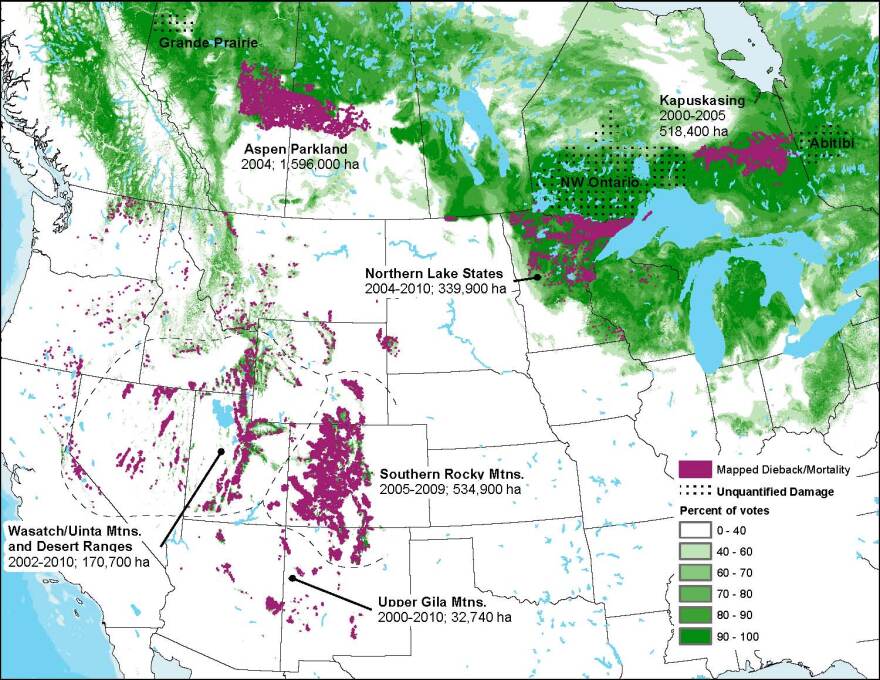In late September and early October, Coloradans swarm to the mountains, clutching cameras and phones, hoping to experience the magical transformation of aspens from green to gold.
A few decades from now, though, those glorious aspen stands are likely to be fewer, as global climate change shifts the places where aspen grow and thrive.
While humans began warming the planet at the dawn of the industrial age, it wasn't until about 10 years ago that multiple stands of aspens began dying, in Colorado and elsewhere in the southern Rockies. From 2000 to 2010, 1.3 million acres in the region saw significant aspen decline.
Researchers named the phenomenon sudden aspen decline, or SAD, and started tracking these stands to learn more about why they were dying. After years of research, they : a long-term drought that culminated in widespread aspen die-off. In essence, during the drought, the climate in those stands became unsuitable for aspen.
"That's what gave us the clue that you could think of SAD as the first wave of climate change impacts to aspen," said James Worrall, a researcher with the U.S. Forest Service in Gunnison, Colorado.

A recent by the Union of Concerned Scientists and the Rocky Mountain Climate Organization on the future of Western forests highlights some of the risks to aspens. The report built upon the work of scientists like Worrall, who have studied the decline of aspens in the Southern Rocky Mountains over the past decade, and have found the future of Colorado's aspen's stands .
Worrall and researcher Gerald Rehfeldt, of the U.S. Forest Service Rocky Mountain Research Station in Moscow, Idaho, have modeled aspen's future across the West. Their bioclimate models show that future climate change will likely result in a significant reduction in aspen in the region. In Colorado, the state may lose 45 percent of its total aspen stands, but could lose even more.
The reason: in some areas, the future climate is simply too dry. Worrall calls these areas, where aspen stand now but one day no longer will, the "lost zones."
"What we are suggesting as far as management in the lost zone is that we don't really try to invest in recovery or restoration of aspen… because there isn't a good long term future for it," said Worrall.
The speed at which this happens depends on the rate at which humans continue to emit carbon dioxide, but many projections show significant loss by 2060.

Worrall hopes forest managers can concentrate restoration efforts, like tree clearing to stimulate aspen growth, in different parts of the forest. Called the "threatened zone," these areas may become less suitable for aspen under climate change, but with some human help the trees may be able to survive.
Worrall, Rehfeldt and others are now zooming in to one part of Western Colorado, working to understand what climate change means for aspen in a specific region. They've chosen the Grand Mesa, Gunnison, and Uncompaghre National Forest, as their focal point. That forest has detailed maps of existing aspen, now Rehfeldt is working on making a bioclimate model specific to that forest.
Rehfeldt says he hopes this modeling can help forest managers understand the changes that might happen on their forest, and what they can do about it, "to give them some tools from which to develop plans," he said.
Aspen aren't just beautiful. They offer superb wildlife habitat, and forest managers have long concentrated on improving the amount of aspen available in a forest, said Jeff Underhill, the Forest Service's regional silviculturalist for the Rocky Mountain Region.
Humans do have some tools available to help aspen regenerate. The trees have a growth hormone that responds to disturbance, so if aspen get knocked down by a windstorm or by a chainsaw, they will start sending up young shoots. Large fires can also be a boon to aspen, and the recent beetle kill epidemic opens up space for new stands.
Underhill hopes to start a large scale monitoring effort for aspens in states like Colorado, New Mexico, and Arizona, if he can get funding for the project, to see how it is responding to these disturbances.
"At a multi-state scale we are interested in monitoring the aspen response to large scale disturbances in recent years."
Worrall agrees that disturbance is good for aspen, but in 50 years, climate change may have changed the available habitat so much that aspen will be gone from familiar places, and maybe popping up in unfamiliar ones.
The new areas, however, will be much smaller than the old ones.
"The area that is suitable for aspen is definitely expected to shrink, because the way mountains are, there is a lot more land at low elevations than there is at high elevations. If the elevation range of aspens goes up there's just less land available for it up there," he said.






